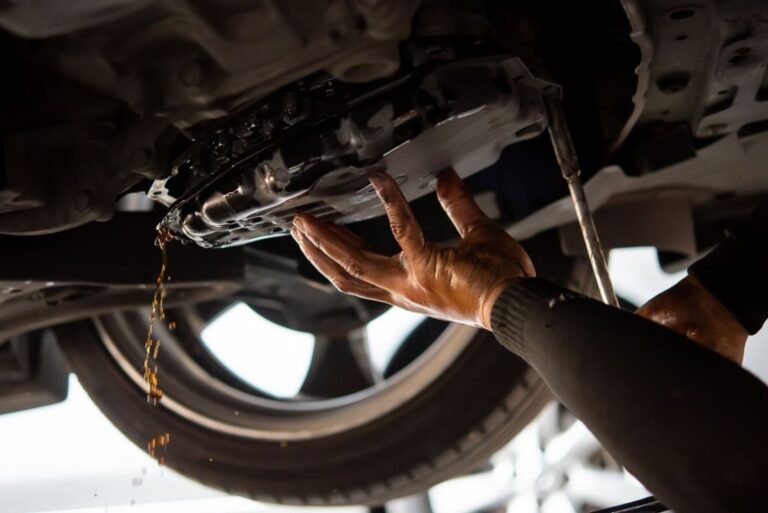Temperature Gauge Goes Up and Down While Driving?

You hop in your car, turn the ignition, and notice the temperature gauge is bouncing around. It goes from normal to hot back down to cool, never quite settling in. Should you be concerned when your car’s temperature gauge fluctuates while driving? In short – yes, you should pay attention when the reading is inconsistent. While brief spikes may be normal, wide swings between hot and cold extremes typically indicate an underlying issue with your vehicle’s cooling system.
This comprehensive article will examine all the possible causes and solutions for an unstable temperature gauge. We’ll cover common problems like a faulty thermostat, leaks, water pump failure, radiator cap problems, head gasket leaks, and loose belts. You’ll also learn how to accurately diagnose the root cause through inspection, pressure testing, OBD2 monitoring, and analyzing patterns in the gauge movement.
Armed with the information in this guide, you’ll be able to identify why your temperature gauge bounces around and determine if it’s a quick fix or major repair. Ignoring fluctuating readings risks serious and expensive engine damage down the road. Being proactive by pinpointing and addressing the issue promptly can save you money and prevent breakdowns. Let’s get started exploring the reasons behind an inconsistent temperature gauge!
Table of Contents
What Does a Jumping Temperature Needle Indicate?
Before diving into the specific issues that cause temperature fluctuation, it’s helpful to understand what exactly that needle activity means.
Your vehicle’s temperature gauge, located on the instrument panel, shows the current operating temperature of the engine. It works by reading the coolant temperature from the sensor located in the cooling system.
The gauge has a normal range your engine should stay within, typically around the halfway mark give or take a bit in either direction. Brief spikes above normal are expected in certain conditions like climbing hills or towing heavy loads. The cooling system is designed to handle short-term increases. However, when the needle constantly jumps between hot and cold extremes during normal driving, that indicates a problem.
This up and down motion means the cooling system is struggling to consistently regulate engine temperature. Hot and cold cycles stress the components and can lead to breakdowns or damage over time. Identifying and resolving the underlying cause of the fluctuation early is recommended.
Monitoring the patterns of the needle movement can provide clues into what’s malfunctioning. Before getting into those details, let’s first look at the common issues that make the temperature gauge go haywire in the first place.
What Causes Temperature Gauge Fluctuations?
Many different cooling system and engine issues can lead to an unstable temperature gauge reading. Here are the most common culprits:
Faulty Thermostat
The thermostat is a small valve within the cooling system that opens and closes to control coolant flow and regulate temperature. When it fails, it leads to a jumping gauge. Here’s how:
- Stuck open – With the thermostat stuck open, it allows continuous coolant flow even when the engine is cold. This prevents the engine from reaching optimal operating temperature. The gauge will read very low or cold.
- Stuck closed – A closed thermostat stops coolant flow, allowing the engine to overheat since heat can’t dissipate. This sends the gauge reading very high.
Replacing the thermostat can resolve temperature fluctuations originating from a faulty unit. This inexpensive repair restores normal coolant control and gauge function.
Cooling System Leaks
Your vehicle’s sealed cooling system operates under pressure. When leaks develop, it causes coolant loss over time. Low coolant levels reduce the system’s ability to absorb and dissipate heat. This leads to spikes or erratic gauge readings.
Potential leak sources include:
- Radiator and hoses
- Water pump
- Reservoir tank
- Thermostat housing
- Freeze plugs
Even small leaks allow air pockets to form which hinder circulation. Visually inspect all components for wetness, stains, or swelling that points to a leak. Use a pressure tester to check for internal cooling system leaks not visible from the outside. Address any issues promptly to avoid coolant depletion and overheating.
Water Pump Failure
The water pump is a key component that circulates engine coolant. When it fails, the reduced or halted flow causes temperature gauge readings to creep up.
Symptoms that your water pump needs replacement include:
- High gauge readings with no visible leaks
- Noise from the pump – squealing, grinding
- Weep hole leaks on the pump itself
Make sure to test the radiator cap as well since a bad cap can produce similar overheating issues. The water pump should be replaced immediately if faulty to restore coolant flow and prevent escalating engine damage.
Radiator Cap Problems
The radiator cap is a simple but vital part of the cooling system. It maintains the system pressure needed for fluid circulation and heat transfer.
Over time, the cap’s sealing surfaces can corrode or weaken. This allows pressure to bleed off, leading to erratic temperature gauge behavior.
Replacing an older, worn radiator cap is a fast and inexpensive fix. Make sure the replacement matches your vehicle’s cap rating for optimal performance.
Head Gasket Leak
A blown or leaking head gasket is a serious issue that absolutely causes the temperature gauge to fluctuate from normal to hot.
The head gasket seals the combustion chamber and provides a critical fluid barrier between coolant and engine oil. When the seal fails, it allows coolant and oil to mix together. The result is coolant depletion, overheating, and rapid gauge spikes.
Other symptoms that indicate a blown head gasket include:
- White exhaust smoke
- Coolant in the engine oil
- Oil dripping into the cylinders
Repairing the head gasket leak is essential to prevent extensive engine damage. Driving with a known head gasket problem risks complete breakdown.
Loose Belts
The drive belts play key roles in engine function. Loose belts affect the cooling system in these ways:
- Loose fan belt – The fan won’t spin fast enough to maintain air flow across the radiator to dissipate heat. This allows the engine to run hotter.
- Loose water pump belt – Reduced or no water pump operation decreases coolant circulation. This also causes high temperature readings.
Inspect belts for cracks, fraying, and proper tension. Tighten any loose belts to the manufacturer’s specifications. This simple adjustment can restore normal operation if slack belts were the culprit.
How to Accurately Diagnose Temperature Gauge Fluctuations?
When your temperature gauge acts erratically, pinpointing the cause involves methodically checking each component using these techniques:
Visually Inspect the Entire Cooling System
Give the radiator, hoses, water pump, thermostat housing, reservoir tank, belts, and other components a thorough visual examination. Look for leaks, damage, loose connections, and deterioration. Make repairs for any issues found.
Use a Pressure Tester
This tool checks for internal cooling system leaks undetectable from the outside. Refill the cooling system, attach the tester, and inspect for drops in pressure over time. Loss of pressure confirms a leak.
Check Engine Codes with OBD2 Scanner
Connect an OBD2 scanner to pull diagnostic trouble codes. Temperature sensor and cooling system fault codes can help zone in on specific issues.
Analyze Gauge Movement Patterns
Note when and how the gauge reading fluctuates during different driving scenarios:
- Cold start – Reading too low could mean stuck open thermostat.
- Acceleration – Spikes may signal water pump or belt issues.
- Extended idling – Creeping high temperatures can indicate coolant leaks or bad radiator cap.
Use patterns to narrow down the potential culprits. Have a helper observe the gauge while you drive if needed.
By combining these troubleshooting techniques, you can accurately diagnose the problem and take corrective action.
Preventing Temperature Gauge Fluctuation
Proper maintenance and operation goes a long way towards preventing temperature gauge problems in the first place. Here are some tips:
- Check engine coolant level and condition regularly. Refill or change as needed.
- Replace aging system components like thermostat, radiator cap, water pump per manufacturer recommendation. Don’t wait for failure.
- Address any leaks, however minor, right away to maintain integrity of the cooling system.
- Avoid habitually driving while overheated. This stresses the head gasket and entire engine.
- Give the engine adequate warm up time before high loads.
- Install an engine oil cooler on performance vehicles or heavy duty use.
With vigilance and proper care, your vehicle’s cooling system and temperature gauge can stay in harmony for the long haul.
Conclusion
In summary, frequent fluctuations of your car’s temperature gauge require attention. The bouncing around signals issues with coolant circulation that will only deteriorate if left unchecked. Top culprits are thermostat failure, leaks, water pump problems, a faulty radiator cap, loose belts, and head gasket leaks.
Approach diagnosis systematically starting with visual inspections, pressure testing, and OBD2 scanning. Analyzing gauge movement patterns provides helpful clues as well. Address any underlying cooling system faults promptly to restore normal gauge readings and prevent expensive repairs down the road.
We hope this comprehensive guide gives you confidence dealing with temperature gauge problems. Our goal was to explore all the potential causes, diagnostics, and solutions so you have the knowledge to resolve this common driving headache. Maintaining your vehicle’s cooling system will keep your engine running happily for years to come. Safe travels!







